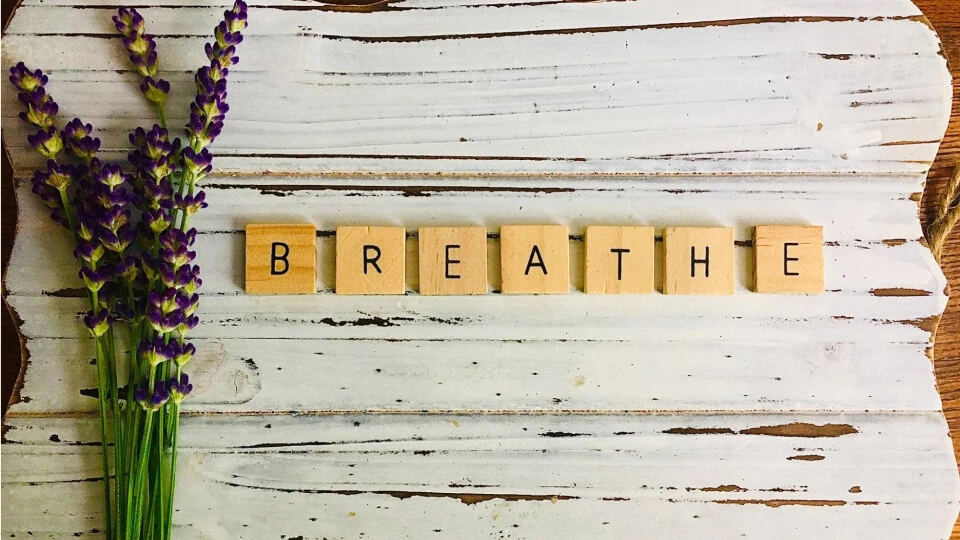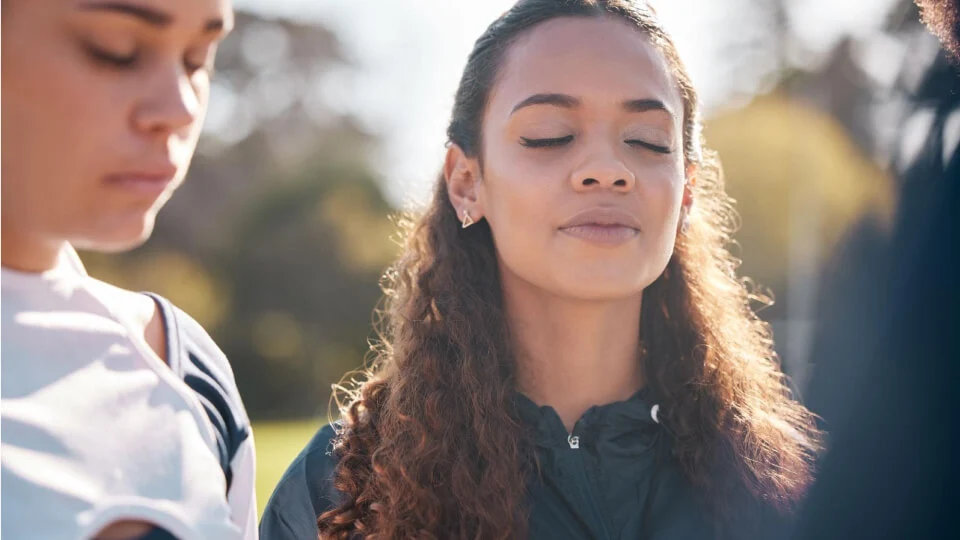
Most of us know what it feels like to have thoughts and emotions running a mile a minute. Maybe you’re lying awake at night replaying a conversation, or your stomach is in knots thinking about what’s next. In moments like these, mindfulness and meditation can feel like a breath of fresh air as mindfulness allows us to reconnect with the present and our body and mind.
But what exactly is Mindfulness?
At its core, mindfulness means choosing to pay attention, on purpose, in this moment, and without judgment. It’s not about emptying your mind or stopping your thoughts (spoiler: that’s impossible!). It’s about how you relate to your experiences, with curiosity instead of criticism.
Our modern understanding of mindfulness comes from Buddhist teachings, specifically the idea of “bare attention”, a simple, non-judgmental awareness of each moment as it comes. Thich Nhat Hanh, the beloved Buddhist monk, describes it as “keeping one’s consciousness alive to the present moment.” And Jon Kabat-Zinn, founder of Mindfulness-Based Stress Reduction (MBSR), defines it as “paying attention in a particular way: on purpose, in the present moment, and non-judgmentally.”
Each of these definitions captures something essential: mindfulness is a way to tune in, to your thoughts, your body, and your life, without getting swept away by the chaos of everyday noise.
This simple mindfulness approach involves:
- Mindful awareness: noticing physical sensations as they arise
- Focus your attention on breath, body, or environment
- Close your eyes (if helpful) to deepen time for meditation practice
And here’s something that might surprise you: mindfulness isn’t about what you’re doing, it’s about how you’re doing it. You can practice mindfulness exercises while walking, brushing your teeth, or savouring your morning coffee or tea – whenever you bring attention to the present moment.
And if you’re doing it with awareness and kindness, that’s mindfulness. You could also be doing those same things while criticizing yourself or getting lost in thought… and that’s something else entirely.
If you’re curious about the broader benefits of mindfulness (and why it’s such a buzzword these days), we’ve explored that in more detail in our earlier blog post.
The Science of Mindfulness
When you’re feeling anxious, your body is actually trying to help you.
It just doesn’t always do the best job of telling the difference between real danger and everyday stress.
So, your brain hits the internal panic button. Your heart starts racing, your breath gets shallow, your muscles tense up.
That’s your sympathetic nervous system triggering stress and anxiety, jumping into fight or flight mode. It’s a survival instinct designed to keep you safe, but not super helpful when what you’re facing is a full inbox or replaying something awkward you said last week.
This is where mindfulness training comes in. Think of it as a pause button for your nervous system.
Instead of staying stuck in overdrive, mindfulness helps send a gentle signal to your brain that you are safe right now.
And this isn’t just a nice idea. Research backs it up. According to the American Psychological Association, mindfulness-based interventions have shown significant effectiveness in reducing symptoms of anxiety.
Regular mindfulness practice has been shown to calm the amygdala, the part of your brain that handles fear, and strengthen the prefrontal cortex, the area that helps you think clearly, manage emotions, and make grounded decisions.
In other words, mindfulness helps shift you out of panic mode and into a more settled, steady state. And over time, mindfulness exercises help rewire your brain to respond differently to stress.
You start to notice a bit more space between what’s happening and how you react. Sometimes, that space is exactly what we need when anxiety starts to creep in.
Effect |
How Mindfulness Works |
| Interrupting Negative Thought Loops | Notice when negative thoughts arise and step off the cycle |
| Reconnecting with Body |
Observe anxiety manifest in your chest or stomach and by noticing it can soften the tension |
| Creating Space Between Stimulus and Response |
Using grounding exercises to pause before reacting. |
Mindfulness is Not a One Size Fits All
Mindfulness is not one-size-fits-all. In fact, it can show up in many ways, and that is exactly what makes it so accessible.
It might look like truly savouring your morning tea instead of rushing through it while scrolling your phone.
It could be taking a steady breath before responding to that stressful email.
Or simply noticing the feeling of your feet on the floor while waiting in line.
The point is, mindfulness is less about what you are doing and more about how you are doing it.
If you are present, aware, and kind to yourself in the moment, you are practicing mindfulness.
On the other hand, you could be meditating and still not be mindful if your inner critic is running the show.
Start with what feels natural for you and allow your practice to grow from there.
Can Mindfulness Really Help Reduce Anxiety?
The short answer is yes, but it is not a quick fix!
Therapy for anxiety, especially meditation and mindfulness, can ease anxiety and reduce anxiety symptoms.
Mindfulness won’t magically erase anxiety or stop uncomfortable thoughts from showing up. What it does offer is a way to respond to those thoughts with steadiness and self-compassion.
It teaches your brain a different pattern, one that is rooted in presence instead of panic.
Think of it like building muscles. Every time you notice your mind racing and gently bring your attention back to the moment, you are strengthening your ability to stay grounded, even when things feel overwhelming.
And that makes a real difference. Anxiety tends to pull us into the future, into the “what ifs” , the unknowns, and the worst-case scenarios. Mindfulness invites us back into the here and now. Often, this moment is manageable. It is something you can work with.
So no, it is not about getting rid of anxiety entirely. It is about learning to meet it in a new way – with awareness, calm, and a little more breathing room.
Research supports this approach. A meta-analysis found that various forms of meditation, including mindfulness practices, lead to decreased physiological markers of stress, such as cortisol levels and heart rate.
The American Psychological Association also notes that mindfulness-based therapy can be especially effective for reducing stress, anxiety, and depression.
How Mindfulness Calms Anxious Feelings
Let’s break it down. Here are a few powerful ways mindfulness works its magic when anxiety starts to take over:
It interrupts the anxious thought loop
You know that feeling when your thoughts start racing, and you can’t seem to stop them? It’s like a hamster wheel in your head, just spinning and spinning with no end in sight.
Mindfulness helps you notice when you’re stuck in that loop, and once you recognize it, you can step off. It’s not about shutting the thoughts down but about creating a bit of distance.
By just being aware of what’s happening, you can start to disengage from the constant mental chatter.
It reconnects you with your body
Anxiety doesn’t just live in your mind. It often manifests in physical ways, too. Maybe you feel a tightness in your chest, your heart starts pounding, or your stomach feels like it’s in knots.
These are all signs that your body is responding to stress.
Mindfulness helps you slow down and tune into these sensations without judgment. Instead of getting overwhelmed, you can notice the tension and allow yourself to soften it, helping you feel more grounded and less consumed by anxiety.
It creates space between stimulus and response
When anxiety hits, the impulse is often to react immediately. Maybe you snap at someone, withdraw into yourself, or just spiral into worry.
Mindfulness offers a pause.
That moment between the trigger and your response can be a game-changer. Instead of automatically reacting, you get a chance to breathe, take a step back, and choose how you want to respond.
It’s like pressing a “pause” button on the automatic reactions, giving you space to respond with more clarity and intention.
Over time, these small, mindful shifts add up. It’s not about instantly eliminating anxiety or making everything “perfect.” It’s about slowly rewiring your brain to handle stress with more resilience, awareness, and calm.
The more you practice, the more you build the capacity to face anxiety with a little more ease and confidence, no matter what life throws your way.
How to Calm Anxiety in 3 Steps
Feeling anxious? Let’s take a quick mindfulness moment together. Try these three steps to help calm your mind:
1. Come Back to the Present
Take a pause. Look around. What do you see? What do you hear? What can you feel right now?
Naming just a few things in your environment helps pull you back into the present moment, away from the anxious thoughts.
2. Focus on Your Breath
No need to change anything, just notice your breath.
Feel the air gently moving in and out of your body.
Let each inhale and exhale be like an anchor, grounding you right here, right now.
3. Check In With Your Body
Where are you holding tension? Maybe it’s in your shoulders, your jaw, or even your stomach.
See if you can soften just a little. If it helps, let out a gentle sigh.
Sometimes, a deep exhale is all it takes to release some of that tightness.
These small mindfulness exercises won’t erase the anxiety, but they let you ride the wave instead of getting pulled under.
Breathing Exercises for Anxiety
When stress hits, your breath can be your best tool. It’s amazing how something as simple as breathing can have such a powerful effect on calming your mind and body.
This quick and simple exercise is something you can do anytime, anywhere, no matter where you are or how chaotic things may feel:
1. Inhale gently through your nose for a count of 4.
Focus on the sensation of the air moving in, it’s all about bringing your attention to the present moment. Notice anxious thoughts drifting in and then gently refocus on the breath.
2. Hold your breath softly for 2 seconds.
This brief pause helps your body absorb the calming effect of the inhale before you exhale. Anxiety may soften as you pause.
3. Exhale slowly through your mouth for a count of 6.
Make the exhale long and steady, letting go of any tension as you breathe out.
4. Repeat 3 to 5 times.
Each cycle brings you closer to a state of calm, reducing the intensity of stress and shifting your nervous system into a more balanced state.
This simple breathing pattern doesn’t just slow your breathing down, but it can reduce symptoms of anxiety and depression. It sends powerful, calming signals to your nervous system, helping to bring your body back into balance and reduce that anxious feeling.
It’s a gentle, accessible way to start retraining your body’s response to stress.
Need a little more support? If you’re new to this or just want some extra guidance, we’ve got a guided video here that will walk you through the process. Whether you’re at home, in the car, or at work, this tool can become your go-to calming technique.
It’s a quick and effective way to reset your mind and body, helping you feel more grounded and focused.
Guided Meditations for Anxiety
Mindfulness is about more than just quick fixes, it’s about building lasting calm.
While brief moments of mindfulness can offer immediate relief, there are meditation practices that can help you develop a sense of tranquility over time.
Here are two powerful meditation practices you can try:
Body Scan Meditation
The body scan is a way to reconnect with your body. You begin by bringing your attention to your toes, slowly working your way up, part by part, all the way to the top of your head.
As you move through each area, simply notice what you feel, no need to judge or change anything.
Is there tension?
Relaxation?
Just allow yourself to be aware of it, without trying to fix anything.
This practice can be grounding and can help you shift from a state of mental overwhelm to a more present, calm awareness.
It encourages you to listen to your body, helping to release tension.
Loving-Kindness Meditation
When anxiety arises, it’s common to become self-critical, even be harsh with ourselves.
Loving-kindness meditation is a practice designed to counter those feelings and invite compassion instead.
In this practice, you silently repeat phrases that can feel as if you are talking to a good friend but that friend is YOU.
- May I be safe.
- May I be peaceful.
- May I be healthy.
- May I live with ease.
As you settle into these phrases, gradually expand your circle of compassion.
First, offer these wishes to yourself, then extend them to loved ones, and even to people who challenge you.
You can end by offering loving-kindness to all beings, everywhere.
It’s surprisingly powerful. This practice helps soften your inner critic and opens the heart, and makes space for gentleness and self-compassion.
Over time, it can be a game-changer in shifting your relationship with anxiety, helping you approach stress and discomfort with a mindset of care rather than judgment.
A Gentle Prompt Before You Go
Take a moment and ask yourself:
What’s one moment today where you could pause for a mindful breath?
It might be during your commute, while doing dishes, or right before bed.
Let that moment be your anchor.
Key TakeAways
Mindfulness isn’t about fixing everything or making anxiety disappear. It’s about gently turning down the volume, not just on the world around you, but also on the noise inside your own mind.
It’s about meeting yourself where you are, with compassion and curiosity.
Whether you’re taking a walk in nature, pausing for a deep breath between emails, or placing a hand over your heart in a difficult moment, mindfulness invites you to come home to yourself. In this space, healing becomes possible.
In a world that moves at lightning speed, mindfulness reminds us that it’s okay to slow down and just be.
FAQs About Mindfulness and Anxiety
1. How long does it take for mindfulness to help with anxiety?
You may feel a small shift right away, like a breath of fresh air. But for lasting change, consistent practice is key. Even 5 minutes a day can make a real difference over a few weeks.
2. Can mindfulness replace anxiety medication?
Mindfulness is a supportive practice, not a replacement for medication. It can work beautifully alongside medication and therapy, but always check with your healthcare provider before making any changes to your treatment plan.
3. How often should I practice mindfulness?
Start small. Even a few minutes a day can make a big impact. Some days will feel easy, others may be messy, and that’s completely okay. The key is showing up and being kind to yourself, no matter where you are.
4. What’s the best mindfulness technique for anxiety?
Everyone is different! Many people find breathwork and body scans helpful, but the best practice is the one that feels right for you. Try a few different techniques and see what resonates with you.
FAQs on Get Reconnected Psychotherapy Services
1. What services do you offer?
We provide virtual psychotherapy and counselling across Ontario, specializing in stress and burnout, anxiety, self-esteem, trauma, ADHD and relationships challenges.
2. Do you offer mindfulness-based therapy?
Yes! We integrate mindfulness-based interventions into therapy sessions to help clients manage anxiety and stress.
We also integrate Acceptance and Commitment Therapy (ACT) in our sessions.
3. How can I book a session?
You can schedule a free consultation through our website or contact us directly.
source https://getreconnected.ca/mindfulness-for-anxiety/







No comments:
Post a Comment